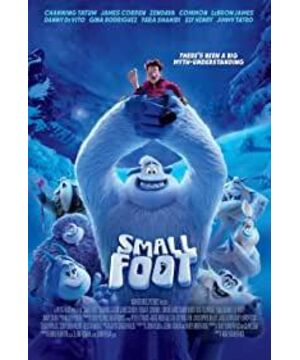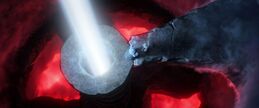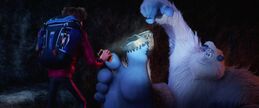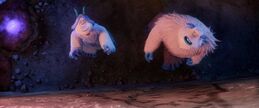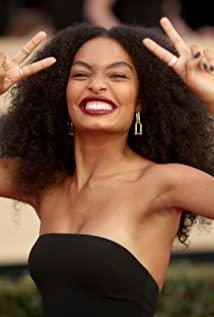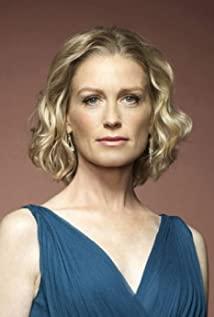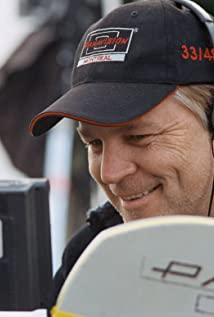This movie gives a general viewing experience a bit like watching a fighting game and seeing some interesting combos .
Establishing a clear and single theme first, then filling it with details and portraying characters to make them plump and fleshy is the usual method of animation film narrative . And often the discussion of these themes is neither scratching the surface nor getting to the bottom of it, focusing on enlightenment, which is very suitable for young people. For example, the whole film theme of "Zootopia" is "everyone has the right to pursue their own dreams", and under this, bullying, equal rights... and some realities are profiled and satirized.
From the point of view of establishing the theme, "Snow Monster" is superior to "Zootopia" because it is not a single theme, but two themes.
The beginning of the film is relatively bland, with isolated villages, quaint way of life, conservative and stereotyped village chiefs, and turbulent years... What to expect? This theme is very old-fashioned (classic): daring to explore vs. stick to the rules . We grew up on this topic, from Galileo to Darwin, from Chinese classes (full of Fang Long’s flavor) to physics classes, have we all vomited? Fortunately, along with the bland theme, there are a lot of jokes and songs and dances, it's okay. Under this big theme, there are also some small concepts, such as the existence of the story of the gong knocker, which is clearly pointed out: the sky is constant, and personal cognition is ignorant and limited, which is regarded as defending the first theme.
From this, there is no suspense in the film until the middle of the film, when Mi Gou takes Po Xi back to the village for a parade. I've also been speculating about the future development. What will the village chief do with Mi Gou and Po Xi? Intimidation or lure or murder? What power is behind him? In short, according to my habitual thinking, I always feel that I will engage in politics later, and add a little love between young men and women to break through the conservative feudal barriers and so on... I seriously underestimated this movie. Facing the bottleneck of the story, the creator made a gorgeous move. This move made my chair lean forward.
With the opening of the village chief's mansion, the story turned to a new chapter. Before this, the village chief's persistent conservative and stereotyped image assumed a villain-like role. However, from the moment he walked into the deep cave with Mi Gou step by step, as a linking figure, his face gradually blurred, and the story became deeper. This paragraph is quite clever, and the content of the footage also hints at a change. The productivity and production methods of the Stone Age displayed from the outside of the village have suddenly transformed into the feeling of the steam age with a bit of alien technology.
The new chapter is actually titled: Real and Dangerous Exploration vs False and Safe Routines. After further discussion under the theme of the first chapter, after adding some attributive words, I suddenly entered the university stage from the middle school stage, and had some dialectical thinking. And the character image of the village chief and the ideology he represents have gradually become fuller. I like the character of the village chief very much. From the beginning, he was covered with stone runes all over his body, and then he went out with all the stone runes in order to protect the children. He completed a natural and smooth transition and reversed the charm. And the story has a clear stand from the beginning, and gradually there is no villain and senior in the back.
In addition, there is another theme buried in the whole film: the conflict, contradiction and understanding and communication between two different ethnic groups (groups). The discussion of this topic is also very skillful, because he is not explicit, and even when I wrote this after watching, most of the impressions about this topic did not come from the lines, but the lens language. For example, Poxi and Mickey communicate through paintings and mobile phones; Migou’s comparison of cave paintings and Poxi’s behavior when they first saw Poxi; in the Yeti Museum in the Human Village, the images of humans hunting snow monsters and the Tang Dynasty where snow monsters ravage the world Cards...and the climax at the end. After reading these, you will naturally have a clear understanding of this topic in your heart.
When I entered the theater, besides me, it was a black couple and a black father and daughter, which inspired me a little bit. If the second theme is embodied or refined into the current racial issues in the United States, it can also be inserted. Is it a bit mean to put black people into the snow monster's perspective? If you think about it, it's not difficult to understand the slightly contrived happy ending at the end.
The use of elements is also very useful. The plot, props that appear in the film, there is no waste, no wasted footage, even a broken tooth, you can find it in the end credits egg. It makes people feel very comfortable, they are arranged clearly and clearly, and they are well served. On the other hand, in domestic film and television, the indifference to details, the foreword does not match the afterword, and some of the things mentioned before are no longer mentioned later, and I really feel so fucking humiliated. (For the kind face and language)
Speaking of details, the film's flaw is that the details used to fill in the subject aren't particularly impressive .
The singing and dancing seemed to be just to cover up the mediocrity of the first half. After the village chief introduced the murals, there was no singing and dancing in my mind. Moreover, the song and dance did not undertake the main narrative. It was quite satisfactory. You would sway when you heard it. I think that if the village chief introduces the mural content, Mickey and Mickey can have a confrontation through singing and dancing, which not only enriches the content, but also makes the transition smoother, which will be very brilliant, like Let it go.
Some small jokes and small burdens are very good in the trailer, but the funny and interesting in the main film are almost the same. The content of a few minutes is spread out to two hours and it is too diluted (now the trailers are getting more and more fooled people).
As for some of the small concepts pointed out by Po Xi, not forgetting the original intention, work and dreams, etc., I think it is redundant and very boring. It's better to cut off the human parts to let them feel at ease and be good paper people.
------------------------------------------
Trivia:
The snow monster "Yeti" in the film comes from the Nepal region, and the human village in the film should also be located in Nepal. But it's actually quite vague. As for the Chinese characters and Chinese in the film, it is estimated that it also takes care of China's box office. In addition, it can be seen from the end subtitles that there are a lot of Chinese creators from beginning to end.
View more about Smallfoot reviews


